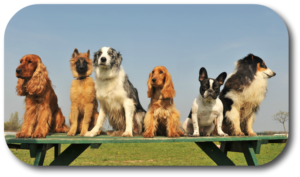We were at a new Home Dog Training Client in Cumming last Wednesday working with him and his one year old Bluetick Coonhound named Jerry. Jerry loved to run to the front door, jump on people, and steal food off the table. The problem was that our client simply didn’t understand that he was really encouraging Jerry to continue these unwanted behaviors by the actions he was displaying. After a few hours, our client understood what he needed to do and Jerry was being the perfect little boy. As we were finishing up, our client mentioned that he had one more thing to discuss. In a few months he would be moving back in with his parents and they had five dogs of their own. He wasn’t sure how his parents’ dogs and Jerry were going to get along. What should he do to make sure that everything would work out just fine?

Robin and I have had up to seven dogs at a time, so we understand the challenge of having our current dogs accept a “new kid on the block”. We would like to provide you with some of our methods if you are thinking of having multiple dogs come together into the pack.
Bringing a new dog into the family is an exciting time for the human “pack” members but can create stress for the non-human pack. Your ultimate goal when introducing a new dog into “the pack” is to create a process that is safe, calm, and focused on your dog’s understanding that you are in control. Let’s first talk about generalities:
Rules of the Road:
- Set reasonable goals when you bring a new dog into your family. Knowing the dogs’ backgrounds as to how well they were socialized will help you manage what will probably happen. Remember and respect that your current dog and/or cat may perceive the new dog to be encroaching on his established territory. This could be very stressful.
- There is no need to rush. Move slowly and in a very calm manner. Slow-paced introductions may help prevent any fear-based or aggressive reactions from developing. If bad behaviors are not reined in from the start, they can become habit and be very hard to change in the future.
- Never leave your pets unattended, even if the new one is in their crate. When two pets meet, it is imperative you watch them at all times. The situation can change suddenly.
- If you have multiple dogs living with you now, introduce each dog one at a time to the new dog to prevent them from overwhelming the newcomer.
- Stay in control of the introduction. If you are not sure how your pet will react, take the necessary precautions to keep him (and you) safe.
- Be patient and adaptable. You will need to teach your new dog to trust you while communicating to your current pets that you will continue to keep them safe. Building good relationships takes time.
- Dogs have a very keen sense of smell. If you are a dog owner, you are well aware of their fondness to smell everything (sometimes at the most inopportune moment).
Let’s now start to get into some of the details of your preparation and implementation:
Dog to Dog:
- Before you bring the new dog (or puppy) home, bring home his scent so your current dogs can be introduced to his smell first. Rub the new dog with a cloth or use a blanket he has slept on and bring it into your home and place it where he will be sleeping.
- Let your current dogs be interested with it, smell it, and nudge it. Try not to have them potty on it. That could manifest into some territorial issues we are trying to avoid.
- In addition, be sure both your current dog and the new dog are up to date on their vaccinations to avoid any risk of infection.
- If you are a fan of The Big Bang Theory, you will understand the concept of Sheldon and not being in his spot. Believe it or not, dogs function in much the same way. When you want to have dogs greet each other for the first time, it shouldn’t be in one of their spots.
Introduce in a Neutral Location:
- Introduce the dogs in a neutral location that is unfamiliar to both dogs. This could be the quiet part of a park or even your front yard. This prevents your current dog from feeling his territory is being threatened.
- Each dog should be on a loosely held six-foot leash and handled by a separate person. It is very important that you stay relaxed so the dogs don’t pick up on any tension or concern you may be feeling.
- Don’t “make the dogs greet each other”. Just walk near each other for a few minutes. One or both of the dogs may ignore each other, which is fine. Just stay upbeat and give the dogs time to get comfortable with the situation.
- If there is a point where they “just don’t want to get any closer”, take a break and continue tomorrow. You can’t rush socialization, safety, and trust.
The most important thing that you should take away from all of this is that your dogs will be telling you if things are going well or not. It is your responsibility to set the scene to allow them to “make this happen”. If you see that “it isn’t happening”, you must back them off and try again later.
Please call Robin or me at (770) 718-7704 if you need any dog training help. We are blessed to have been your local dog training professionals for over sixteen years. We have trained over 5,000 great dogs and loving families and are ready to help you.

Follow Us!